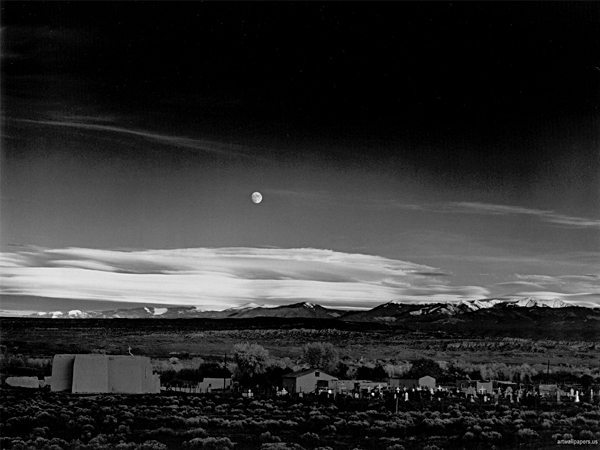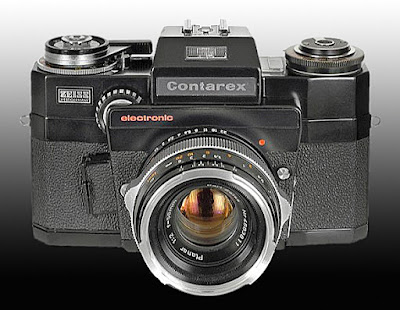Ansel Adams was born on this day in 1902.
All photographers, including Leica owners, can learn a lot from him. His approach to photography with the Zone system, which he created, is still as much up to date today as it was when he worked his magic with black and white photography. This is part of what makes him of great interest to the Leica community, because Leica these days has probably a much wider number of followers still using analog photography than any other camera out there. By applying his techniques, I have certainly been able to produce better black and white photographs than I would otherwise have been able to.

Ansel Adams at work
This is not going to be an article on Ansel Adams’ camera and darkroom techniques. For that he is doing a much better job in his books than I ever could. Instead this is a remembrance of one of the giants of photography, an individual that will forever be remembered as one the absolute masters of his craft.
The L-Camera blog has published a two part video of Ansel Adams from 1958. In this 20-minute presentation you get an insight into his working methods, his own interests and attitude to art, and his gigantic amount of camera equipment.
You will accompany the photographer through the entire process of analog photography, from the precise light reading of the object, the correct exposure settings of the camera and onto the right development of the photos in the darkroom.
But you will also see another, much lesser known side of Ansel Adams, that of an accomplished pianist. As a matter of fact, he initially planned to become a concert pianist, but the onset of arthritis kept him from doing so. It wasn't until then that he began his career as a photographer.
The piano music accompanying the video was all played by Adams. Listening to it is a captivating opportunity to see the other artistic side of this great artist.
I am showing only one example of his work. It is almost impossible to make a reasonable selection from his many published photographs. This one stands out because it was taken without the possibility of an exposure reading. He came upon this scene while driving home from an assignment. The light was changing quite rapidly and Adams had barely time to set up his camera and tripod. It is to his credit to be able to accurately determine the exposure simply based on experience.

Moonrise over Hernandez
For the video go to: AnselAdams
Many people are satisfied just to see and enjoy the incredible images Ansel Adams produced, but for many the question remains, what cameras did he use. As simple as the answer might seem, that question is actually not easy to answer. Even Ansel Adams himself had problems with that. In an interview with John Adams recalled:
"Well, people have asked me what kind of cameras I used. It's hard to remember all of them. Oh I had a box Brownie #1 in 1915, 16. I had the Pocket Kodak, and a 4 x 5 view, all batted down. I had a Zeiss Milliflex. A great number of different cameras. I want to try to get back to 35 millimeter, which I did a lot of in the 1930s. Using one of the Zeiss compacts. In the 20s and into the 30s, I would carry a 6-1/2 x 8-1/2 glass plate camera -- that was a little heavy. And I had a 4 x 5 camera, then of course we went to film, to film pack, things became a little simpler.”
Zeiss Contarex

Hasselblad
Arca Swiss

Leica R4
We do know that his account is far from complete for no other reason that he also used larger than 4 x 5 cameras. As a matter of fact, many of his iconic images were taken with 8 x 10 cameras. I recall a video about Ansel Adams where he briefly shows some of his camera equipment. There, for 35mm he used a Zeiss Contarex with a variety of lenses. Medium format photography was covered by Hasselblad. As a matter of fact, one of his photographs of the Half Dome was taken with a Hasselblad. In 2014 one of his 4 x 5 cameras was offered for auction. It was an Arca Swiss with several lenses. Ultimately, we will never know what all the cameras were that Ansel Adams used, and it doesn’t really matter. What matters is the incredible amount of work he produced. We are very fortunate that to this day we are able to see this wok on display in museums, galleries and other venues. Thank you Ansel Adams.
For other articles on this blog please click on Blog Archive in the column to the right
To comment or to read comments please scroll past the ads below.
All ads present items of interest to Leica owners.
______________________________________________________________________
______________________________________________________________________

Buy vintage Leica cameras from
America's premier Leica specialist
http://www.tamarkinauctions.com/ http://www.tamarkin.com/leicagallery/upcoming-show

Buy vintage Leica cameras from
America's premier Leica specialist
http://www.tamarkinauctions.com/ http://www.tamarkin.com/leicagallery/upcoming-show
Click on image to enlarge
Order: info@gmpphoto.com
Please make payment via PayPal to GMP Photography
Click on image to enlarge
Order: info@gmpphoto.com
Click on image to enlarge
Order: info@gmpphoto.com
Click on image to enlarge
Order: info@gmpphoto.com
Please make payment via PayPal to GMP Photography
Click on image to enlarge
Order: info@gmpphoto.com
Please make payment via PayPal to GMP Photography
Click on image to enlarge
Order: info@gmpphoto.com
Please make payment via PayPal to GMP Photography















I am not familiar with the Zeiss Contarex. Is it equal to Leica equipment?
ReplyDeleteYes, it was in any respect. As a matter of fact, the Contarex was the only camera besides the Swiss Alpa, that was made with the same extremely tight tolerances as the Leica cameras. Unfortunately the camera line didn't survive, it was discontinued in the early 70s. An interesting fact is that the Contarex was the first camera that was used in outer space, not in a space capsule, but actually out in space. That was during the first American space walk when Ed White used it to take photographs outside the space capsule. The camera was mounted on top of an experimental maneuvering device which had a hand grip from which a tube extended to both sides, with nozzles at the end. Below was a tank with a propellant which was supposed to give the astronaut some means of maneuverability, but it proved to be worthless. But the camera worked quite well.
DeleteDoes the zone system still have some relevance in these days of digital photography?
ReplyDeleteNot in its original form. Adams used it as a system to coordinate exposure with film development. That obviously does not apply to digital photography. However, it can be used in a modified form, with color as well as black and white only sensors. A few simple tests can easily determine the dynamic range of the cameras sensor. With other words, it is possible to determine at which point overexposure will render white without detail. The same can be done for underexposure. Having the sensor range in terms of f-stops will then allow the camera user to place the exposure such that either highlights or shadow areas are not lost.
DeleteThis practice, just like the zone system, ultimately requires a spot meter. Personally I find it easier to use a hand held meter for this, although an in-camera spot meter would work also.
What hand held lightmeter do you recommend?
DeleteBasically any handheld lightmeter should offer incident as well as reflected metering. But there are considerable differences. Most handheld lightmeters are sold as incident meters. To switch to reflected metering in most cases it is necessary to remove the incident dome and replace it with a reflected metering attachment. That works, but is very unhandy because it requires removing one accessory and replacing it with another. Meters like most of the Gossen lightmeters, for instance, allow the incident dome to be slid to the side and thus convert instantly to the reflected mode. Not only is this substantially faster, it also eliminates the possibility of losing or misplacing one of the other attachments. Another disadvantage is that many meters, when used in the reflected mode, work with an angle of view of 45 degrees. That is very wide and makes accurate reflected readings more difficult to take. Here again, the Gossen meters have the advantage of only a 30 degree angle of view. But even that is often too wide. Several of the Gossen meters offer a spot reading attachment with a viewfinder for accurate aim, that allows the angle of view to be narrowed to 15 and 7.5 degrees, also by just moving a switch. Most other narrow angle attachments offer only one angle of view, in many cases just 10 degrees. I still use a Gossen Luna Pro SBC and a Luna Pro F. The Luna Pro F has the additional advantage of being capable to read flash also, both with apertures up to f/90. That is of no great consequence with most digital cameras, but with view cameras it is of a definite advantage over meters that go only to f/32 or f/45. Compared to most other meters, these also have the advantage of being analog instead of digital. For me the readout is quicker and gives the entire shutter speed-F/stop choices and a glance instead of only one. Call me old fashioned, but I see the analog layout as an advantage.
DeleteWhat is the difference between an incident and a reflected light meter?
DeleteA reflected light meter reads the intensity of the light reflected by the subject. Unless used properly, a reflected light meter will render erroneous readings dependent on the brightness of the subject. An incident light meter reads the intensity of the light source. This automatically renders what is called true tonality. With other words, light subject automatically are rendered light while dark subject automatically are rendered dark.
DeleteI am glad to see that good old Ansel didn't ignore Leicas
ReplyDeleteI wonder what Ansel Adams would think of digital photography?
ReplyDelete